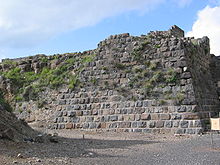Humpback cuboid



The individual stones of a basement are called humpback cubes .
The stone bulges outwards like a hump on the visible side and is usually only roughly hewn. The protruding ends are also called wimpfen or bosses . The square are often side by a three to six centimeters wide rim shot framed. If the visible side is also smoothly reworked and arched like a cushion, it is called an upholstered cuboid. Humpback ashlar with edging and cushioned ashlar have only appeared on a larger scale in the German-speaking area since the late 12th century. Visible sides machined in the shape of a pyramid or tent roof result in a diamond cuboid .
With the end of the Staufer period , humpback blocks were used less often and mainly as corner blocks, while the quarry stone masonry dominated the wall surface . However, humpback cubes experienced a renaissance in the late Middle Ages and the early modern period .
Hunchback cuboid in the high medieval secular building
Between the middle of the 12th and the middle of the 13th century, humpback cubes found widespread use on the ring walls and mountain tidies of castles as well as on city gates and towers, especially in the southwest German-speaking area (including Switzerland, Tyrol and eastern France) . However, humpback cubes are only suitable for closer dating if the greatest scientific care is taken, as in some regions, for example in Franconia , the Palatinate and Alsace , they continued well into the post-Staufer period - in some cases up to the 16th and 17th centuries. 17th Century - were used. The oldest well-dated humpback square castle in German castle construction is that of Konrad III. Rothenburg built around 1142 . Whether the appearance of the humpback cuboid in the middle of the 12th century had an iconographic-political background, for example as an import from the Holy Land, has been discussed again and again, but has not yet been conclusively proven. On the contrary, the use of humpback ashlars in some crusader castles can also be viewed as a European import.
For the widespread use of the humpback square from the 13th century onwards, it can be assumed that it was mainly used as a design element for the large wall surfaces in castles and city walls. Older attempts at explanation, especially from the 19th century, which saw the humpback brickwork as a method to prevent scaling ladders from being pushed up , are not convincing, since the ladders can also be leaned differently.
A "regional special form" of the humpback ashlar masonry is the so-called Cyclops masonry or megalithic masonry (for example at Meersburg Castle ), which, according to recent studies of Swiss and Upper Swabian castles, dates to around 1180-1250, i.e. not an older one, as previously assumed Represents stage of development.
Outside of the south-west German-speaking area, high medieval humpback cubes can also be found in some Hohenstaufen castles in southern Italy and in some fortifications in southern France.
In Germany and Europe
The article "Excursion II" names the following castles with humpback square structures: Altenstein, Bodenlauben, Brandenburg / Werra, Breuberg, Burgsinn, Greifenstein, Hardenberg, Hirschhorn, Kipfenberg, Kyffhausen (Oberburg), Lichtenstein / Saxony, Löwenstein, Magenheim, Mildenburg, Münzenberg, Prozelten , Rappoltstein, Ravensburg, Rieneck, Rotenberg, Rothenfels, Rothenburg / oT, Scharfenberg, Sigmaringen, Steinsberg, Trifels, Walburg, Wertheim, Wildenburg.
And the Palatinate: Altenburg / Saxony, Basel (Switzerland), Eger (Cheb, Czech Republic), Frankfurt / Main, Gelnhausen, Hagenau, Nuremberg. Oberehnheim, Regensburg, Wimpfen.
For Italy, the castles Baria, Gioia dell Colle, Lagopesole and the fortress Lucera are mentioned.
literature
- Daniel Reicke: "of strong and great flüejen". A study of megalithic and humpback brickwork on castle towers in the area between the Alps and the Rhine (Swiss contributions to the cultural history and archeology of the Middle Ages, vol. 22), Basel 1995, ISBN 3-908182-07-7 .
- Patrickschicht: Hunchback cuboid in Austria - medieval masonry as a carrier of meaning . Michael Imhof Verlag, Petersberg 2011, ISBN 978-3-86568-532-2 .
- Article "Excursion II", pp. 27–30, IN: Publication series Heft 3, Museum and Art Collection Schloß Hinterglauchau, City of Glauchau, 1981, GDR (on the application and chronological classification of humpback blocks in German castles and palaces and in Italy, comparison with the Humpback blocks on the preserved keep of Waldenburg Castle in Saxony )
Web links
Individual evidence
- ↑ Thomas Steinmetz: The royal palace Rothenburg ob der Tauber . Schmid, Brensbach 2002, ISBN 3-931529-04-5 , here: p. 114 ff.
- ^ Albrecht Rieber, Karl Reuter: The Palatine Chapel in Ulm. Report on the results of the Schwörhaus excavation in 1953 . 2 volumes. Konrad, Weißenhorn 1974, ISBN 3-87437-104-2 and ISBN 3-87437-105-0 .
- ↑ Thomas Steinmetz: The royal palace Rothenburg ob der Tauber . Schmid, Brensbach 2002, ISBN 3-931529-04-5 , here: p. 147 ff.




